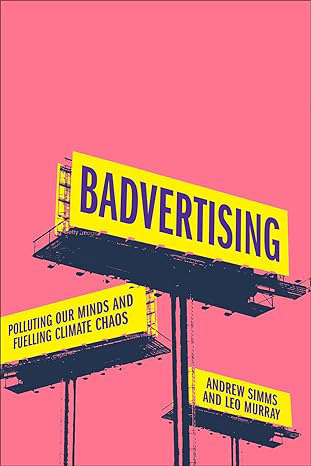Why is it legal to advertise products that are driving us and the planet to destruction? Why should advertisers be able to tempt us to buy an SUV [an oversized car – ed] as if it were no more damaging to the environment than a bicycle? And what can we do about it?
All these questions and more are tackled in Badvertising.
We are surrounded by advertising: online, on TV, in the street, on public transport, and – more insidiously – through sponsorship, whether it’s BP sponsoring the British Museum or British Airways sponsoring England Rugby.
We are being encouraged to consume the very things which we need to immediately stop consuming if we are to have any hope of keeping global warming to 2º C. Cheap flights, huge cars, meat and dairy, luxury goods of every description – all come with a huge carbon footprint.
But you wouldn’t know that, to look at the ads.
Land Rover seeks to persuade us that its 2.3 tonne urban tank is somehow sustainable (you can, after all, choose plant-based textile seat covers). British Airways tells us how it plans to be net zero by 2050, in part by removing plastic bags from flights.
All of this is clearly greenwash.
Cars (especially big ones, even if they’re part-electric) are inherently not sustainable. Flying is a major source of carbon emissions and there is no credible path to net zero that doesn’t involve a huge reduction in flights taken.
So what can we do?
In the UK, we have codes of conduct for advertisers, with adherence enforced by the Advertising Standards Authority (ASA).
The codes say ‘Advertising must not encourage behaviour grossly prejudicial to the protection of the environment’ and it should also not encourage ‘anti-social behaviour’ – both of which you’d think would rule out advertising SUVs which are not only so damaging to the environment, but also, due to their weight and height, extremely dangerous to pedestrians.
But there’s a problem: the ASA is funded by the advertising industry itself. Although the agency claims to be independent, in 2022 it upheld only two percent of the complaints made to it about misleading environmental advertising.
Even if a complaint is upheld, the worst that usually happens is that the advertiser is rebuked and made to withdraw the ad – usually long after the ad campaign has finished. As a result, advertisers can get away with almost any amount of greenwashing.
Self-regulation clearly isn’t working – so what’s to be done?
The authors look at the campaign to ban tobacco advertising in the UK. It started in 1962, after the publication of a Royal College of Physicians report on smoking, and finally succeeded in 2003, when all tobacco advertising and sponsorship was banned.
There was much resistance from tobacco companies as well as obstruction from government. Badvertising recounts then-prime minister Tony Blair’s decision in 1997 to exempt Formula One from the ban on sponsorship by tobacco companies after the Labour party received a £1m donation from the company’s head, Bernie Ecclestone.
The authors also look at places that have banned billboards – famously São Paolo, but also four US states and many US towns.
Amsterdam has banned ads for fossil-fuel cars, fossil-fuel companies and budget airlines. The Dutch city of Haarlem has also banned ads for industrially-produced meat.
In the UK, councils including Norwich and Liverpool have adopted policies to ban advertising for environmentally-damaging products (however, the book doesn’t make it clear enough that these bans apply only to council-owned sites: councils have no jurisdiction over privately-owned sites).
All this is great but clearly there needs to be an overarching, government-level policy. The authors suggest this should include a tobacco-style ban on high carbon advertising; funding the ASA through taxes rather than industry contributions; giving the regulatory system the power to issue fines; and suspending advertising campaigns while a complaint is pending.
Whether the next (presumably Labour) government decides to act on this remains to be seen, but I’m not holding my breath.
I enjoyed Badvertising but there is a big issue with the book: it appears to have been brought out in a rush and not properly edited.
One of its claims (that we see 6,000 – 10,000 ads a day) was debunked by Radio 4’s More or Less programme, which said that the figure ‘really isn’t accurate’ and was based on speculation.
I found multiple instances of missing citations, non-sequiturs, unexplained jargon, and sentences that I could make no sense of even after reading them several times.
There are several references to an intriguingly-titled Australian anti-advertising campaign called BUGA UP, but I had to google it to find out what it was (Billboard Utilising Graffitists Against Unhealthy Promotions, if you’re interested). I found all of this quite distracting, which is a shame as there’s some good stuff in here.
It is insane that we allow advertising of products which are driving the climate crisis. This book shows that it doesn’t have to be that way.


